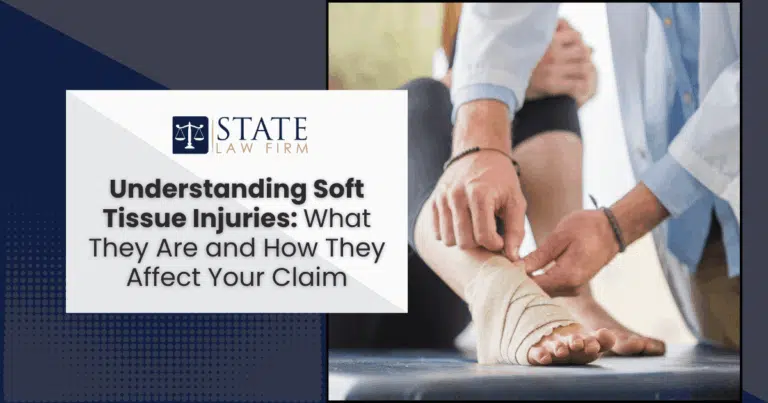Soft tissue injuries are among the most common—and most misunderstood—types of injuries that follow car accidents, slips and falls, or other personal injury incidents. While they might not show up on an X-ray, their impact on a person’s daily life can be significant, affecting everything from mobility and comfort to the ability to work or care for loved ones. In fact, according to the National Center for Biotechnology Information, soft tissue injuries account for over 40% of emergency room visits related to musculoskeletal trauma.
At State Law Firm, we’ve seen firsthand how challenging it can be for injury victims to get the compensation they deserve for these often “invisible” injuries. Insurance companies frequently downplay soft tissue damage, leaving injured individuals to fight uphill battles. That’s why our team of young, driven attorneys in Sherman Oaks is committed to helping clients navigate these claims with precision and care. Whether it’s negotiating with insurers or preparing for trial, we aim to evolve into strong litigators who advocate fiercely for our clients.
If your soft tissue injury stems from a car accident, our Sherman Oaks car accident lawyers are here to guide you through the process, step by step.
In this guide, we’ll explain what soft tissue injuries are, how they can affect your life, and what it takes to successfully pursue a personal injury claim. Let’s break it down.
What Are Soft Tissue Injuries?
Soft tissue injuries refer to damage affecting muscles, ligaments, and tendons—essential structures that support your body’s movement and stability. Unlike broken bones, these injuries don’t always show up on imaging scans, which can make them more difficult to diagnose and prove in an insurance claim.
Common Types of Soft Tissue Injuries Include:
- Sprains: Stretched or torn ligaments, often occurring in ankles, knees, or wrists.
- Strains: Injuries to muscles or tendons caused by overstretching or overuse.
- Contusions (bruises): Result from blunt force trauma, causing bleeding beneath the skin.
- Tendonitis: Inflammation of tendons, often from repetitive stress or strain.
- Whiplash: A neck injury resulting from rapid back-and-forth motion, frequently seen in car accidents.
Frequent Causes of Soft Tissue Injuries:
- Car accidents (especially rear-end collisions)
- Slip and fall incidents
- Workplace accidents
- Sports-related trauma
Pro Tip: Even if your injury doesn’t feel serious at first, soft tissue damage can worsen over time. Seeking prompt medical care can prevent complications and strengthen your legal claim.
The Impact of Soft Tissue Injuries on Daily Life
Soft tissue injuries may not always look severe from the outside, but their effects can ripple through every part of a person’s day-to-day routine.
How These Injuries Can Affect You:
- Persistent pain and soreness that interferes with sleep, work, or daily activities
- Limited mobility that affects driving, exercising, or lifting even light objects
- Long recovery periods that may require physical therapy, rest, or assistive devices
- The possibility of chronic pain or re-injury, especially without proper treatment
For many of our clients, the real toll of these injuries is emotional—missing work, canceling plans, and feeling misunderstood by insurance companies who minimize their pain. That’s where having a legal team that genuinely listens and fights for you makes all the difference.
Navigating Your Insurance Claim for Soft Tissue Injuries
Filing an insurance claim for a soft tissue injury isn’t as straightforward as it should be. Since these injuries often lack visible evidence, insurance companies may delay, deny, or undervalue claims—unless you’re prepared.
Steps to Strengthen Your Claim:
- Document your symptoms immediately after the accident and continue recording your pain levels, limitations, and treatments.
- Get evaluated by a medical professional as soon as possible. Gaps in treatment are often used against injury victims.
- Follow all treatment plans, including physical therapy and follow-up visits.
- Keep detailed records, including doctor’s notes, receipts, time off work, and communications with the insurance company.
Pro Tip: Never give a recorded statement to the other party’s insurance company without legal guidance. It may be used to reduce your payout.
At State Law Firm, we help clients navigate these conversations and prepare strong, evidence-based claims that insurance companies can’t easily dismiss.
Common Misconceptions About Soft Tissue Injury Claims
Too often, clients come to us after being told their injury is “minor” or that they don’t have a case. These myths can cost injury victims the compensation they rightfully deserve.
Here Are a Few Common Myths—And the Truth Behind Them:
- “It doesn’t hurt that much, so it must not be serious.”
Many soft tissue injuries develop over time. Delayed pain is common, especially with whiplash and strains. - “Insurance won’t cover soft tissue damage.”
Wrong—soft tissue injuries are covered under most liability and personal injury protection policies. The key is proper documentation and experienced representation. - “If there’s no broken bone, there’s no claim.”
Some of the most debilitating injuries don’t involve fractures. Chronic pain, reduced mobility, and long recovery periods are very real damages.
Our role is to help clear up these misconceptions and help our clients advocate for the full value of their injury, not just what the insurer is willing to offer.
The Role of Medical Documentation in Supporting Your Claim
When it comes to soft tissue injury claims, documentation is everything. Insurance companies and courts alike want clear, credible evidence connecting your injury to the accident and showing the extent of your suffering.
Essential Types of Medical Documentation:
- Emergency room and urgent care visit summaries
- MRI, CT, or ultrasound results (if applicable)
- Physical therapy records
- Notes from physicians detailing your symptoms, progress, and prognosis
- Prescription records for pain management
In some cases, expert witnesses—such as orthopedic specialists or physiatrists—may also be brought in to explain the severity and likely trajectory of your injury.
Pro Tip: Start a journal from day one. Record your pain levels, what activities you can or can’t do, and how your injury affects your mood, work, and sleep. This firsthand account can make a huge difference in settlement negotiations.
At State Law Firm, we work closely with medical professionals and know how to build compelling claims backed by credible, persuasive evidence. We take pride in helping our clients move from frustration to resolution, with the financial recovery they deserve.
Let us help you take the next step toward healing and justice. Whether you’re recovering from a car accident or a slip-and-fall, our dedicated team in Sherman Oaks is ready to listen, advocate, and fight for your future.


